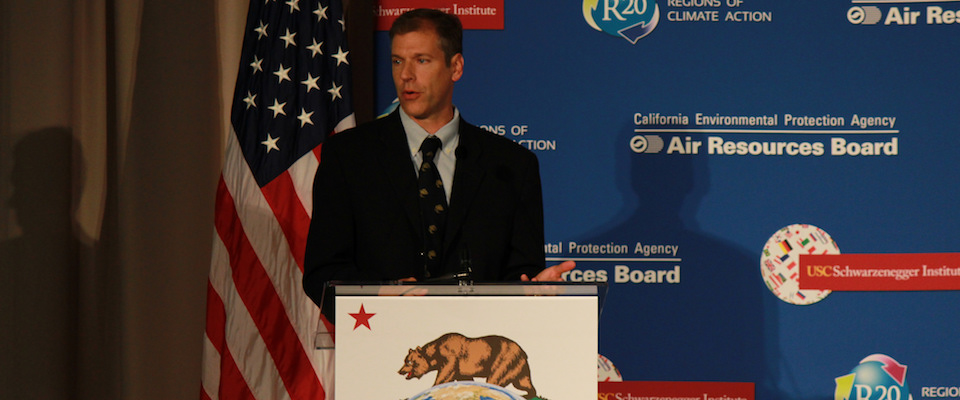The Global Climate Action Summit that wrapped recently in San Francisco was trumpeted as a “subnational” approach to climate change solutions, a riposte to the regressive environmental policies of the Trump administration. For three days, delegates from diverse international municipalities, provinces, states and corporations discussed ways to cut carbon emissions and mitigate global warming.
California Governor Jerry Brown was the host of the summit, and he closed the proceedings with a speech that harkened back to his “Moonbeam” days.
International climate accords at least keep leaders pointing in the right direction. Until they don’t.
With science under attack from President Trump and others, Brown said in closing remarks, “we’re going to launch our own satellite, our own damn satellite, to figure out where the pollution is and how we’re going to end it, with great precision.”
A subsequent press release stated that the California Air Resources Board and Planet Labs, a company in San Francisco that operates earth-orbiting imaging and monitoring satellites, will develop technology to identify sources of greenhouse gas emissions, posting all collected data to the public domain.
Brown did not offer details on how much the project will cost, or how the state will fund it. And the proposal begs the question: Do we really need more data-gathering from space? Or do we need real progress in cutting emissions as aggressively as scientists have posited is necessary—right here on the ground? For that matter, do we need more climate summits?
The fact is that virtually every climate conference to date has produced stirring speeches and laudable goals but little meaningful progress. Under the Kyoto Protocol, which the US signed but did not ratify, total greenhouse gas emissions in the United States were to be cut by 7 percent below 1990 levels. By 2014, however, according to the U.S. EPA, emissions had increased 7.4 percent. Globally, concentrations of CO2, the leading contributor to man-made climate change, have surpassed 400 parts per million (long considered the line we dare not cross) and continue to climb.

International climate accords at least keep leaders pointing in the right direction. Until they don’t. We saw that in 2017 with Donald Trump’s abandonment of the Paris Climate Agreement. With that in mind, the San Francisco summit did succeed in highlighting the deep disparities that exist between the Trump White House and, well, almost everyone else.
David Ackerly, Berkeley professor of integrative biology and a delegate to the summit, sounded hopeful that California could still lead on climate change. “On the one hand” he said, “you have the U.S. pulling out of the Paris Climate Accords, and on the other you have California meeting its own carbon reduction goals ahead of schedule. You came away with a real awareness of the varying degrees of progress, of things happening both slow and fast.”
Cal atmospheric scientist Inez Fung is far less optimistic. In the lead-up to the summit, she observed that all the dire signs of a warming planet—longer and deeper droughts, fiercer and more frequent wildfires, increased flooding—were predicted by computer models 30 years ago, “and now I’m feeling it. I’m experiencing it.”
And as Fung told CALIFORNIA in 2016, the Paris targets, while commendable, are not sufficient to keep the world from surpassing the 2-degree Celsius increase in temperature that scientists warn will destabilize the climate. “The Paris Agreement is important to get us to slow [emissions] down, but with what we have already put in the atmosphere … 2 degrees is gone. Even if you slow down current emissions, overall emissions are still increasing. That’s how things work, and the land and ocean cannot remove that CO2 fast enough.”
Even with such dire views circulating in the scientific community, the summit functioned as a pep rally of sorts, heartening those who still hope to find ways to head off catastrophe.
Severin Borenstein remains unconvinced of the efficacy of a subnational approach to climate change. He called any effort that doesn’t have federal support a “tough road.”
Said Cal conservation biologist Steve Beissinger, “Trump is endangering everyone in the nation and the world with his policies, and it feels kind of sad to be an American right now. We’ve really lost momentum in the U.S. with this administration. But it was clear at the summit that we’re seeing a lot of progress on the local and regional levels. And that involves areas where you wouldn’t necessarily expect it, including a number of red states. A lot of southern states, for example, are finding themselves at the forefront of climate change impacts with hurricanes, rising sea levels, and new and expanding diseases. They’re aware that they’re vulnerable.”
Multiple commitments were agreed to at the summit—more than 500, in fact—ranging from a $4 billion solutions pledge from a group of philanthropists to a “clean cookstove” initiative that will help residents of developing countries transition from wood and charcoal to cleaner cooking fuels. Individually, such initiatives may seem minor, but their collective impact is significant, insists summit delegate Whendee Silver, a Berkeley professor of ecosystem ecology and biogeochemistry. Silver was heartened by enthusiasm at the summit for carbon sequestration, particularly land management techniques that can lock carbon into the soil, such as planting trees and composting rangelands.
“And we can do this with existing technology,” said Silver, who researches composting as a means of maximizing soil carbon sequestration. “I also talked with several business representatives at the summit, including some from McDonald’s. We’re seeing tremendous corporate interest in transforming waste into a resource, into a means for improving profits, growing food and increasing carbon storage. It was encouraging.”
But Severin Borenstein, a Berkeley professor of business administration and public policy and the faculty director at the Energy Institute at the Haas School of Business, remains—like Beissinger—unconvinced of the efficacy of a subnational approach to climate change. He called any effort that doesn’t have federal support a “tough road” and pointed out that creating new infrastructure and changing consumer behavior requires big money. “And the smaller the entity the less funding at its disposal, so the less effective it is.”
That said, Borenstein continued, California has a unique opportunity to take the pole position on climate change policy.
“It’s often said that California would have the world’s fifth largest national economy [if it were a sovereign state], and that’s true. But more than that, it’s an extremely powerful knowledge economy, with tremendous technological and intellectual capital. That creates an advantage for the state. Ideally, we’d like worldwide coordination on climate change, or failing that, at least [American] federal leadership. But we aren’t going to get that, so California becomes a major player.”
For California to succeed in that role it will have to exert even greater global influence—and fast.
“For several years, there’s been this aspiration of ‘bending the curve’ downward on CO2 by 2020,” said Ackerly. “It’s an admirable goal, a spectacular goal, but it just doesn’t seem attainable now. It’s hard to reconcile that dream with reality. And really, it doesn’t depend so much on what happens in California—it depends a lot on what happens in China and India [where CO2 emissions remain extraordinarily high due to rapidly growing economies and abundant coal-burning]. For a meaningful downward trend, we need to bend the curve quickest in those countries with the largest economies and the highest outputs of greenhouse gases.”






















